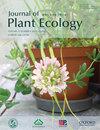Leaf stoichiometry of common species along altitude gradients in the Qilian Mountains, China
IF 3.9
2区 环境科学与生态学
Q2 ECOLOGY
引用次数: 0
Abstract
Investigating the variations in leaf stoichiometry among plant common species at different altitudes, along with the factors that influence these variations and the adaptation strategies employed, holds significant importance for comprehending biogeochemical cycles amidst global environmental changes. In this research, we measured soil organic carbon and nutrient concentrations, as well as leaf stoichiometry for plant common species at five altitudes (2400 - 3200 m with an interval of 200 m) within the Qilian Mountains of Northwest China. This study aims to enhance our understanding of how plant common species in mountainous regions exhibit adaptable responses to altitude variations and how potential environmental changes in the future might impact their leaf functions. Results showed that the leaf C: N: P stoichiometry of plant common species varied differently with increasing altitude. Across altitudes, mean annual temperature (MAT), soil total phosphorus (STP), mean annual precipitation (MAP), soil water content (SWC) and soil nitrate nitrogen (NO3--N) were the main factors influencing leaf element concentrations of plant common species. However, leaf stoichiometric ratios were mainly determined by MAT, MAP and soil total nitrogen (STN). The effects of MAT and MAP on both leaf element concentrations and leaf stoichiometric ratios of plant common species were found to be significant. Plant growth in the study area was mainly limited by P. The results not only highlight the adaptive strategies employed by plants, but also help deepen the understanding of leaf stoichiometry, establishing connections between individual plant species and broader plant community composed of these common species.中国祁连山海拔梯度常见物种的叶片化学计量学
研究不同海拔地区常见植物叶片化学计量特征的变化,探讨影响这些变化的因素及其适应策略,对理解全球环境变化中的生物地球化学循环具有重要意义。本研究对祁连山5个海拔高度(2400 ~ 3200 m,间隔200 m)的土壤有机碳、养分浓度和常见植物的叶片化学计量特征进行了测定。本研究旨在加深我们对山区常见植物如何对海拔变化表现出适应性反应以及未来潜在环境变化如何影响其叶片功能的认识。结果表明:随着海拔的升高,常见树种叶片C: N: P化学计量特征存在差异。在不同海拔,年平均温度(MAT)、土壤全磷(STP)、年平均降水量(MAP)、土壤含水量(SWC)和土壤硝态氮(NO3—N)是影响植物常见种叶片元素浓度的主要因素。而叶片化学计量比主要由MAT、MAP和土壤全氮(STN)决定。MAT和MAP对常见植物叶片元素浓度和叶片化学计量比的影响均显著。研究结果不仅突出了植物的适应策略,而且有助于加深对叶片化学计量学的认识,建立植物个体物种与由这些常见物种组成的更广泛的植物群落之间的联系。
本文章由计算机程序翻译,如有差异,请以英文原文为准。
求助全文
约1分钟内获得全文
求助全文
来源期刊

Journal of Plant Ecology
生物-植物科学
CiteScore
4.60
自引率
18.50%
发文量
134
审稿时长
3 months
期刊介绍:
Journal of Plant Ecology (JPE) serves as an important medium for ecologists to present research findings and discuss challenging issues in the broad field of plants and their interactions with biotic and abiotic environment. The JPE will cover all aspects of plant ecology, including plant ecophysiology, population ecology, community ecology, ecosystem ecology and landscape ecology as well as conservation ecology, evolutionary ecology, and theoretical ecology.
 求助内容:
求助内容: 应助结果提醒方式:
应助结果提醒方式:


